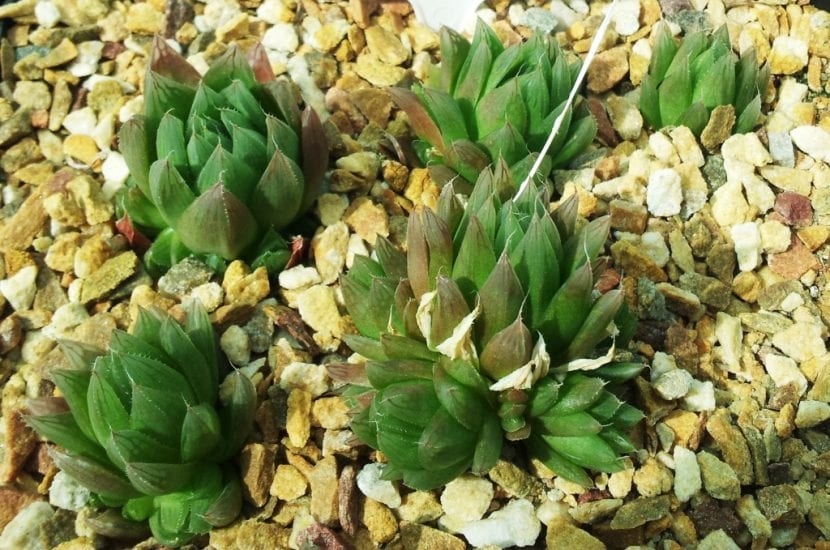
H. cooperi var pilifera
Image - Wikimedia / Stan Shebs
La haworthia cooperi It is one of the succulent plants that we can most easily find for sale. And this has its reason: it is very pretty, resistant, produces small but showy flowers, and as if that were not enough, it is easy to multiply.
As it does not grow much, it is one of those ideal species to use in succulent compositions. What's more, taking care of her is not complicated at all, and less if we take into account a series of things that I will explain to you now.
How is it?

H. cooperi var. truncated
Image - Wikimedia / Levi Clancy
La haworthia cooperi It is a crass or succulent non-cactaceous evergreen plant native to South Africa. It was described by John Gilbert Baker and published in shelter Bot. 4 1870 the year. It is characterized by forming rosettes of 30 to 40 oblong-lanceolate leaves, light green in color, with a flat upper surface and a convex underside. It produces flower stalks of about 20cm in height at the end of which sprout whitish and very small flowers, less than 1cm.
Its growth rate is rather slow; in fact, it only grows a little fast from when the seed germinates until it reaches a diameter of 4-5cm. Later it does not grow much more in width, although you will see that it has a great tendency to take out suckers.
Varieties
There are different varieties:
- Haworthia cooperi var. cooperate
- Haworthia cooperi var. dielsian
- Haworthia cooperi var. doldii
- Haworthia cooperi var. Gordonian
- Haworthia cooperi var leightonii
- Haworthia cooperi var. pilifera
- Haworthia cooperi var. truncated
- Haworthia cooperi var. Venusta
How do you take care of yourself?

H. cooperi var. gordoniana
Image - Flickr / salchuiwt
If you want to have a copy, we recommend that you provide it with the following care:
Location
Being a rather small plant, can be had both in the garden and on the patio or terrace. Of course, in any case it must be in an area where it is in sunlight all day, but only if it has been used to it before, otherwise it could burn.
Earth
It grows in sandy, and even rocky soils, so that the cultivated land must be:
- Garden: with good drainage. Mix if necessary the soil with perlite, claystone, volcanic clay or similar at 50%.
- Flower pot: it can be had simply in the cheek; Although it does not go bad either with black peat mixed with perlite or river sand mixed in equal parts.
Irrigation
The frequency of watering the haworthia cooperi it will be almost always the same. During the fall and, above all, the winter, you do have to water a lot less, but in general with one or two irrigations a week will be fine. If you live in an area where frost occurs, give it water once a month.
And by the way, when you water, only wet the soil, never the plant, otherwise it could get sunburned or rot.
Subscriber

H. cooperi var venusta
Image - Wikimedia / S Molteno
It is a plant that grows a good part of the year, except when the temperature drops below 15ºC or exceeds 35ºC. This means that, depending on the weather, it will remain very active for an average of six months.
To be able to be healthy, apart from water needs to be paid regularly in spring and summer, either with specific fertilizers for cacti and other succulents following the instructions specified on the package, or with one or two small tablespoons of Blue nitrophoska every 15 days.
Planting or transplanting time
Late winter, when the risk of frost has passed. If it is potted, it must be transplanted every two years when it is young. Once it reaches its final size, it will be enough to renew the substrate every 3 or 4 years.
Multiplication
La haworthia cooperi multiplies by seeds and suckers in spring-summer. Let's see how to proceed in each case:
Seeds
The step by step to follow is as follows:
- First, a tray must be filled - it must be at least 20cm in diameter by about 5cm high, with holes - with black peat mixed with 50% river sand.
- Then, it must be watered conscientiously.
- The next step is to spread the seeds, ensuring that they are not piled up.
- They are then covered with a thin layer of black peat.
- Finally, the tray is placed in a bright place but not in full sun.
They will germinate in 2-3 weeks.
Young
The suckers can be separated from the mother plant when they are easily manipulated in size, such as 3-4cm. They are then planted in individual pots, and voila 🙂.
Plagues and diseases
La haworthia cooperi It's very tough. The only thing to be careful with mollusks (snails and slugs), they are animals that enjoy eating their leaves. But do not worry, that with the advice that we offer you in this article you can keep them away.
Rusticity

H. cooperi var leightonii
Image - Wikimedia / Abu Shawka
It resists frosts of up to -3ºC, but it needs protection against hail, especially it is young.
What did you think of this crass plant? Did you know her? Now you know that it is easy to maintain, as well as having a very interesting ornamental value 🙂.